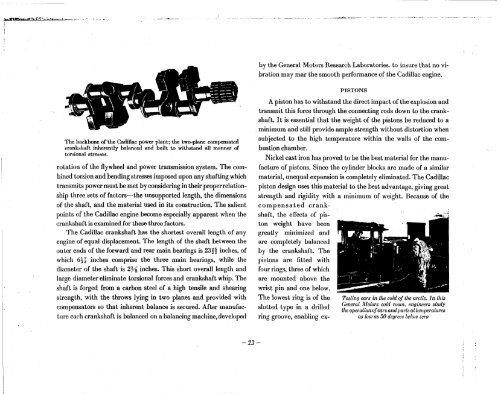1930 Cadillac Brochure Front Cover - GM Heritage Center
1930 Cadillac Brochure Front Cover - GM Heritage Center
1930 Cadillac Brochure Front Cover - GM Heritage Center
You also want an ePaper? Increase the reach of your titles
YUMPU automatically turns print PDFs into web optimized ePapers that Google loves.
y the General Motors Research Laboratories, to insure that no vibration<br />
may mar the smooth performance of the <strong>Cadillac</strong> engine.<br />
The backbone of'the <strong>Cadillac</strong> power plant; the two-plane compensated<br />
crankshaft inherently balanced and built to withstand all manner of<br />
torsional stresses.<br />
rotation of the flywheel and power transmission system. The combined<br />
torsion and bending stresses imposed upon any shafting which<br />
transmits power must be met by considering in their proper relationship<br />
three sets of factors—the unsupported length, the dimensions<br />
of the shaft, and the material used in its construction. The salient<br />
points of the <strong>Cadillac</strong> engine become especially apparent when the<br />
crankshaft is examined for these three factors.<br />
The <strong>Cadillac</strong> crankshaft has the shortest overall length of any<br />
engine of equal displacement. The length of the shaft between the<br />
outer ends of the forward and rear main bearings is 23 ff inches, of<br />
which 6\l inches comprise the three main bearings, while the<br />
diameter of the shaft is 2¾ inches. This short overall length and<br />
large diameter eliminate torsional forces and crankshaft whip. The<br />
shaft is forged from a carbon steel of a high tensile and shearing<br />
strength, with the throws lying in two planes and provided with<br />
compensators so that inherent balance is secured. After manufacture<br />
each crankshaft is balanced on a balancing machine, developed<br />
PISTONS<br />
A piston has to withstand the direct impact of the explosion and<br />
transmit this force through the connecting rods down to the crankshaft.<br />
It is essential that the weight of the pistons be reduced to a<br />
minimum and still provide ample strength without distortion when<br />
subjected to the high temperature within the walls of the combustion<br />
chamber.<br />
Nickel cast iron has proved to be the best material for the manufacture<br />
of pistons. Since the cylinder blocks are made of a similar<br />
material, unequal expansion is completely eliminated. The <strong>Cadillac</strong><br />
piston design uses this material to the best advantage, giving great<br />
strength and rigidity with a minimum of weight. Because of the<br />
compensated crankshaft,<br />
the effects of piston<br />
weight have been<br />
greatly minimized and<br />
are completely balanced<br />
by the crankshaft. The<br />
pistons are fitted with<br />
four rings, three of which<br />
are mounted above the<br />
wrist pin and one below.<br />
The lowest ring is of the<br />
slotted type in a drilled<br />
ring groove, enabling ex-<br />
[••• ^^59ij<br />
^•"^'.•:i<br />
Testing cars in the cold of the arctic. In this<br />
General Motors cold room, engineers study<br />
llie operation of cars and parts at temperatures<br />
as lotv as 50 degrees below zero<br />
-23

















